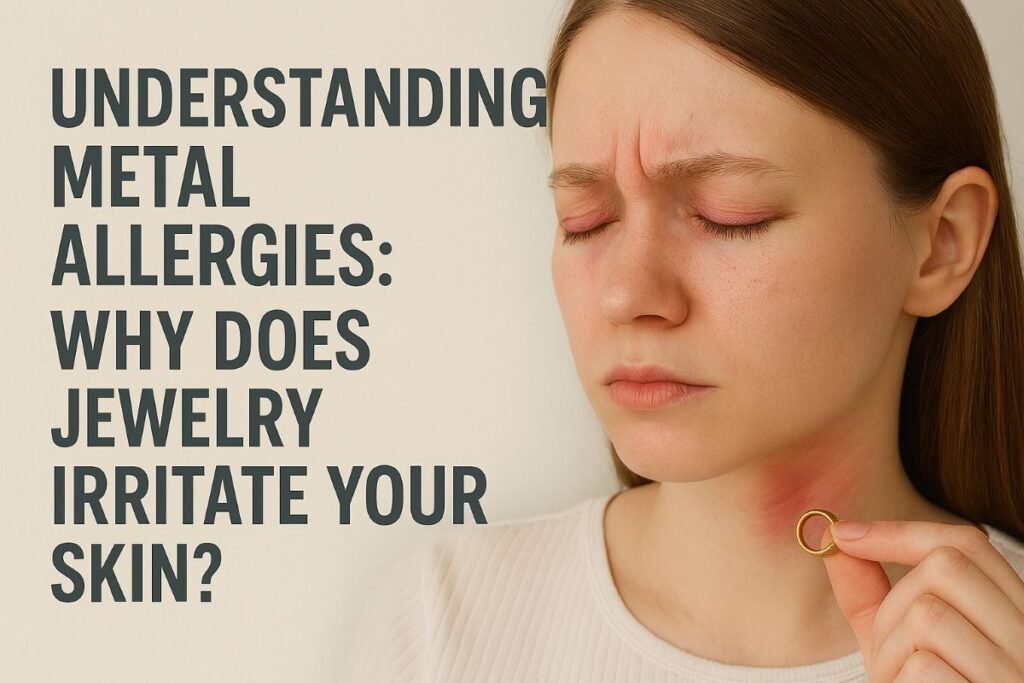A metal allergy happens when your immune system overreacts to certain metals. Instead of ignoring them, your body treats them like a threat. This leads to redness, itching, or even painful rashes wherever the metal touches your skin.
The reaction is called allergic contact dermatitis. It’s not dangerous, but it’s uncomfortable—and often persistent. Even short contact with jewelry can trigger symptoms that last for days.
Unlike food or pollen allergies, metal allergies usually develop over time. You might wear a ring or necklace for years before suddenly reacting to it. Once your skin becomes sensitive, the reaction can return every time you’re exposed.
Why Does Jewelry Cause Reactions?
Jewelry can cause skin irritation for a few main reasons:
1. Nickel Content
Nickel is the number one cause of metal allergies worldwide. It’s found in earrings, rings, necklaces, and watchbands—especially in inexpensive or fashion jewelry. Even a small amount can trigger a reaction in sensitive individuals.
2. Metal Mixtures
Most jewelry isn’t made from pure metals. Gold, silver, and other materials are mixed with alloys to make them stronger. These alloys may contain metals like copper, nickel, or cobalt—all potential allergens.
3. Moisture and Friction
Sweat, humidity, and skin friction can speed up metal release. The more your skin is exposed to heat and moisture, the more likely it is to absorb reactive ions from the metal.
4. Tarnish and Corrosion
Over time, metal can oxidize or tarnish, especially if it’s not properly cleaned. This corrosion interacts with your skin and increases the chance of irritation.
Who Gets Metal Allergies and Why?
Anyone can develop a metal allergy, but certain factors make it more likely:
- Genetics. If your family has a history of skin sensitivities, you might be more at risk.
- Frequent exposure. Piercings, watches, and rings worn daily increase your exposure.
- Women and younger people. Studies show they develop metal allergies more often—possibly due to more frequent jewelry use.
- Existing skin conditions. If you already have eczema or dry skin, you’re more prone to allergic reactions.
Some people are allergic to one metal, while others react to several. Once you develop an allergy, it usually lasts a lifetime.
How to Prevent Metal Allergy Reactions
You don’t have to give up wearing jewelry—you just need to wear it wisely. Here’s how to protect your skin:
- Choose hypoallergenic metals like titanium, niobium, or platinum.
- Avoid nickel-containing jewelry, especially for piercings.
- Use barrier products like jewelry protectant sprays or clear nail polish.
- Keep jewelry dry and remove it before sleeping, swimming, or sweating.
- Clean your jewelry regularly to remove dirt, sweat, and cosmetic buildup.
- Look for certifications or labels that say “nickel-free” or “hypoallergenic.”
If your skin still reacts, consult a dermatologist. They can perform a patch test to identify exactly which metals you’re allergic to.
Jewelry should make you feel confident—not uncomfortable. If your skin flares up every time you wear a certain piece, it’s probably trying to tell you something. Metal allergies are manageable once you know the cause. With the right metals, proper care, and smart habits, you can wear jewelry again without fear.
I am Satyam Pandey, a gemologist with a Diploma in Polished Diamond Grading from KGK Academy, Jaipur. I love writing about jewelry, gems, and diamonds, and I share simple, honest reviews and easy buying tips on JewellersReviews.com to help you choose pieces you’ll love with confidence.

